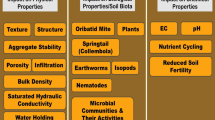Abstract
Barshad’s method of calculating clay formation from the chemical analyses of the whole soil, the clay fraction, the nonelay fraction, and the mechanical analysis was applied to a large number of soils to determine the effect of climate, topography, parent material, vegetation and time on amount of clay formation. The amount of clay formed from 100 g of the nonclay fraction of the parent material was used as the yardstick for comparing clay formation in the different soils.
It was found that for a true evaluation of the effect of these factors on clay formation, it is necessary to determine clay formation in every horizon of a profile and that all soil profiles should be sectioned into horizons which are as nearly alike in thickness as possible. Maximum clay formation in a soil profile occurs in the horizon which is about 2–10 in. below the surface rather than at the immediate surface; as a rule, the amount of clay forming decreases below this maximum horizon. An increase in moisture and temperature enhances clay formation. The temperature factor mainly affects clay formation in the Great Soil Groups in the following order: Podzols > Gray Brown Podzols > Brown Earths > Chernozems > Prairies > Red and Yellow Earths (Latosols) > Laterites. Poor drainage enhances clay formation. Grass-type vegetation is more effective in clay formation than tree-type. Clay formation is greater from the finer grained and the more basic rocks. The more easily rocks fragment, the more clay is formed. The increase in age of a soil is believed to be expressed in the same manner as an increase in the intensity of clay formation, namely, as an increase in clay formation with depth and as an increase in the thickness of a soil profile. It was concluded that clay formation is relatively slow: clay forms at a rate ranging from 0.00001 g to 0.002 g of clay per year per 100 g parent material or from 0.6 to 120 lb of clay per acre foot of parent material per year.
Similar content being viewed by others
References
Anderson, M. S. and Byers, H. G. (1930) Character of the colloidal materials in the profiles of certain major soil groups: U.S. Dept. Agr. Tech. Bull. 228, 24 pp.
Basilevitch, N. I. (1955) A review of the biological cycle of mineral elements: Potchvovédénie No. 4.
Barshad, I. (1955) Soil development. Chemistry of the Soil. (Bear, F. E., Ed.): Reinhold Publishing Corporation, New York, 373 pp. (pp. 1–52).
Brown, I. C. and Byers, H. G. (1938) Chemical and physical properties of certain soils developed from granitic materials in New England and the Piedmont and of their colloids: U.S. Dept. of Agr. Tech. Bull. 609, 56 pp.
Brown, I. C, Rice, T. D. and Byers, H. G. (1933) A study of claypan soils: U.S. Dept. Agr. Tech. Bull. 399, 43 pp.
Byers, H. G., Alexander, L. T. and Holmes, R. S. (1935) The composition and constitutions of the colloids of certain of the great groups of soils: U.S. Dept. Agr. Tech. Bull. 484, 39 pp.
Denison, I. A. (1930) The chemical composition of the colloidal material isolated from the horizons of various soil profiles: J. Agr. Research, v. 40, pp. 469–483.
Holmes, R. S. and Edgington, G. (1930) Variations of the colloidal material extracted from the soils of the Miami, Chester and Cecil series: U.S. Dept. Agr. Tech. Bull. 229, 24 pp.
Jenny, H. (1941) Factors of Soil Formation: McGraw-Hill Book Co., Inc., New York, 281 pp.
Kovda, V. (1956) Composition minerale des plantes et formation des sols: VI. Congres International de La Science du Sol, Paris, 1956, Rapports, v. E, pp. 201–206.
Liebig, Justus (1852) Chemistry in its Application to Agriculture and Physiology: John Wiley, New York, 401 pp.
Marbut, C. F. (1935) Atlas of American Agriculture, part III, Soils of the United States: U.S. Government Printing Office, Washington, 98 pp.
Mickelson, G. A. (1942) Mineralogieal composition of three soil types in Ohio with special reference to changes due to weathering as indicated by resistant heavy minerals: Ph.D. Dissertation, The Ohio State University.
Van Der Merwe, C. R. (1941) Soil groups and sub-groups of South Africa: Union of South Africa Dept. of Agr. and Forestry, Chemistry Series No. 165, 316 pp.
Weaver, J. E. (1936) Root development of field crops: McGraw-Hill Book Co., New York, 117 pp.
Author information
Authors and Affiliations
Rights and permissions
About this article
Cite this article
Barshad, I. Factors Affecting Clay Formation. Clays Clay Miner. 6, 110–132 (1957). https://doi.org/10.1346/CCMN.1957.0060110
Published:
Issue Date:
DOI: https://doi.org/10.1346/CCMN.1957.0060110




